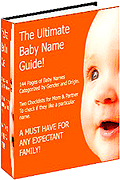Names and Trends - Uncommon Baby Names
by: Martin Smith
The crib is where your baby will spend a lot of their time and you want to be sure they are safe. Below are some of the questions (with the answers) that are asked about crib safety. Topics such as mattress position, how to place your baby in the crib, and general safety standards are discussed, as are other issues. If you need further information you can search the Internet and visit baby furniture stores.
Q. Are there safety standards for baby cribs?
Yes there are some very exact standards for your baby’s crib. In 1974 it was made law that cribs should no longer be painted with lead based paint. It was discovered that the ingestion of lead (from any source) could cause learning disabilities and other difficulties in young children. The slats of the crib must be no more than 2 3/8 inches apart, this is to prevent your baby from getting his body or head stuck between the bars causing injury or strangulation. The side bar should be 26 inches above the mattress when it is in its lowest position. If your child is more than an inch taller than the sidebar it is time to move him into a regular bed.
Q. Are there some hazards in my baby’s crib that I need to be aware of?
Your mattress must fit snugly in the crib; an ill-fitting mattress could cause your baby to slip between the mattress and the side bar causing suffocation. The mattress height should be able to be adjusted into at least three different levels. When your baby becomes more mobile you will want to put the mattress in the lowest position to prevent your baby from climbing or falling out. The slats should be tight, loose slats could pinch little fingers. Do not put the crib near a window to prevent your baby from possibly falling out or becoming tangled in Venetian blind cords.
Q. What are some historical facts about the crib?
Here is a short chronological time line of crib facts:
1973 - The standard for crib slats was to be no more than 2 3/8th inches apart to prevent your baby from slipping through or getting their head stuck. Also, double latches for drop-down sidebars were to become the norm.
1976 - The standard for cutouts in the crib end panels are presented. The end panels must not have any decorative cutout designs. Children were getting their limbs or heads caught causing serious injury or death.
1978 - Cribs must now be painted with non-toxic finish.
1981 - Two models of cribs with cutouts are recalled.
1988 - A voluntary standard addresses mattress support hardware, failure of glued or bolted connections, drop-side latch failure and loosened teething rails.
1990 - No corner posts or projections can be more than 1/16th of an inch above the drop-side.
1998 - California and Washington mandate that hotel cribs must meet the same standards set for full-size cribs
1998 - Portable cribs must now meet the same standards as full-sized cribs.
Q. How can I tell when my baby is ready for a regular bed?
When your child stands more than a couple of inches taller than the sidebar with the mattress in the lowest position. If your child is climbing out of the crib, for his safety put him in a regular bed.
Q. How should I put my baby to sleep in his crib?
(continued...)
Baby Crib Safety - Frequently Asked Questions
Page 2
About The Author
Martin Smith is a successful freelance writer providing advice for consumers on purchasing a variety of Nursery Bedding which includes Baby strollers, Baby car seats, and more! His numerous articles provide a wonderfully researched resource of interesting and relevant information. For more information vist http://www.1st-babies.com
|
